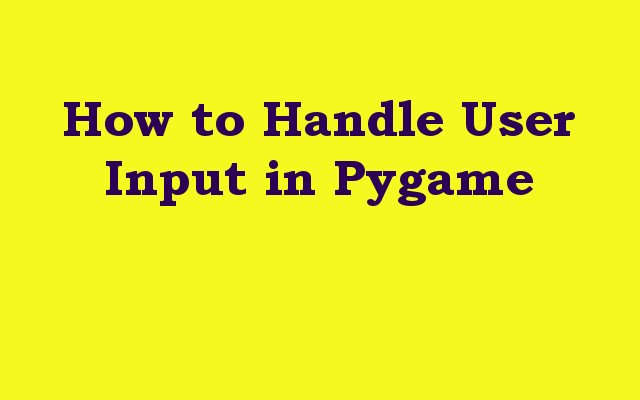In this Pygame article we want to learn How to Handle User Input in Pygame, so Pygame is powerful framework for creating 2D games in Python, and when your building games than handling user input such as mouse clicks, keyboard presses and gamepad movements are an important process, in this article we are going to talk about these concepts.
How to Handle User Input in Pygame
So first step in handling user input in Pygame is to understand event loop. Pygame uses an event driven architecture, it means that it always listens for events such as mouse clicks or keyboard presses and responds to them accordingly. event loop is the main loop of a Pygame game and is responsible for detecting and handling events.
This is an example of how to set up Pygame event loop, in this example Pygame event loop listens for QUIT event, and that is triggered when user clicks the close button on the game window. if this event is detected than game window is closed, and program exits.
|
1 2 3 4 5 6 7 8 9 10 11 12 13 14 15 16 17 |
import pygame pygame.init() # Create game window screen = pygame.display.set_mode((800, 600)) # Gam loop while True: for event in pygame.event.get(): if event.type == pygame.QUIT: pygame.quit() exit() # Update game state # Draw graphics pygame.display.flip() |
One of the most common forms of user input in games is keyboard input. Pygame provides simple way to detect keyboard input using the pygame.key module.
This is an example of how to detect keyboard input in Pygame, in this example code we have detected KEYDOWN event, which is triggered when a key is pressed. after that we checks which key was pressed using event.key attribute and perform a specific action based on the key that was pressed. in this case we are just printing something in the console.
|
1 2 3 4 5 6 7 8 9 10 11 12 13 14 15 16 17 18 19 20 21 |
import pygame pygame.init() # Create game window screen = pygame.display.set_mode((800, 600)) # Game loop while True: for event in pygame.event.get(): if event.type == pygame.QUIT: pygame.quit() exit() if event.type == pygame.KEYDOWN: if event.key == pygame.K_SPACE: print("The spacebar was pressed.") # Update game state # Draw graphics pygame.display.flip() |
Another common form of user input in games is mouse input. Pygame provides several ways to detect mouse input such as mouse clicks and mouse movements.
|
1 2 3 4 5 6 7 8 9 10 11 12 13 14 15 16 17 18 19 20 21 |
import pygame pygame.init() # Create game window screen = pygame.display.set_mode((800, 600)) # Game loop while True: for event in pygame.event.get(): if event.type == pygame.QUIT: pygame.quit() exit() if event.type == pygame.MOUSEBUTTONDOWN: if event.button == 1: print("The left mouse button was clicked.") # Update game state # Draw graphics pygame.display.flip() |
In this example code we have detected MOUSEBUTTONDOWN event, which is triggered when a mouse button is clicked. after that we check which mouse button was clicked using event.button attribute and performs specific action based on the mouse button that was clicked.

